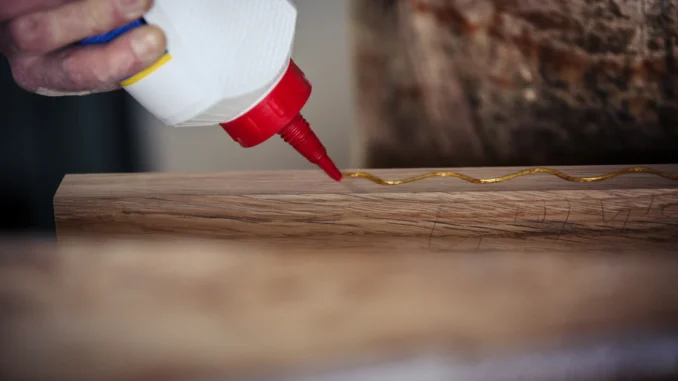
Why Knowing the Drying Time of Wood Glue is Crucial
Wood glue is a powerful bonding agent used in almost every woodworking project. Whether you’re crafting a piece of furniture, repairing a wooden item, or creating a custom design, the strength of the bond is essential. One question that often arises is: How long does wood glue take to dry? The drying time can vary, but it directly impacts the success of your project.
Properly managing the drying time ensures that the glue holds the pieces together securely. If you don’t wait long enough for the glue to fully bond, the joint may not be strong, potentially ruining your project. On the other hand, rushing the drying process can lead to weak adhesion or distortion. Knowing the drying time for wood glue allows you to plan and execute your work effectively. In this guide, we will explore everything you need to know about wood glue drying, from the factors that influence it to tips for speeding up the process.
Factors That Influence How Long Wood Glue Takes to Dry
The drying time for wood glue is not a one-size-fits-all number. Several variables can affect how long it takes for the glue to dry, including the type of glue you’re using, the wood material, and environmental conditions. Let’s take a closer look at each of these factors.
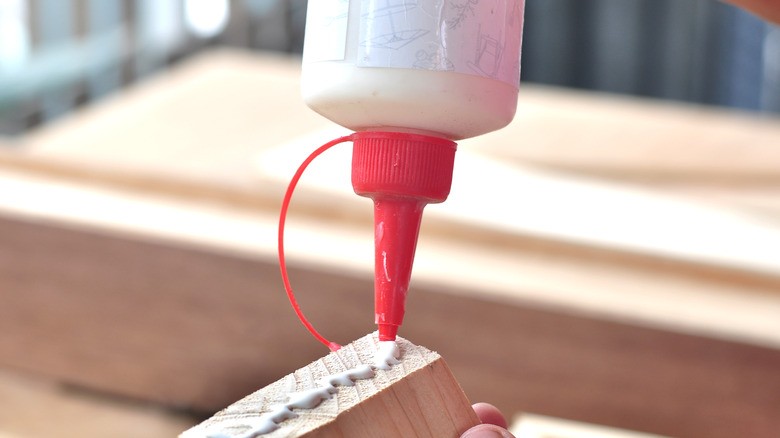
Type of Wood Glue: PVA, Epoxy, and Polyurethane
The most obvious factor that determines how long wood glue takes to dry is the type of glue you’re using. There are several kinds of wood glue, and each has its unique characteristics, including drying times. Here are the three most commonly used types:
- PVA (Polyvinyl Acetate): PVA is the most commonly used wood glue, especially in carpentry and furniture making. It typically dries relatively fast, with an initial set time of 30 minutes to 1 hour. However, it may take 24 hours to achieve full strength. PVA glue is best for projects where you need to bond wood to wood without worrying about heavy-duty stress immediately.
- Epoxy: Epoxy is a two-part glue system, requiring a hardener to be mixed with the resin. It offers an extremely strong bond, but it takes much longer to set compared to PVA. Generally, epoxy requires 24 hours to fully cure, although this time can be shorter or longer depending on the specific product and environmental conditions.
- Polyurethane: Polyurethane glue dries faster than PVA and epoxy, often reaching an initial set time of 1 to 2 hours. However, like epoxy, it may take 24 hours or more to fully cure. Polyurethane glue is moisture-activated, which means it works best when the wood is slightly damp. This glue is ideal for outdoor projects or applications where water resistance is important.
When asking how long does wood glue take to dry, you should first consider the type of glue you’re using. Each glue has different drying and curing times, which will influence your project’s timeline.
Wood Type and Moisture Content
The type of wood you are bonding plays a significant role in how long the glue will take to dry. Softwoods such as pine or cedar typically absorb glue and moisture faster than hardwoods like oak or maple. Because softwoods absorb the glue more readily, they may allow for a quicker drying time compared to hardwoods.
Another consideration is the moisture content of the wood. If the wood is freshly cut or has a high moisture content, the glue may take longer to dry. High moisture levels in wood prevent the glue from drying properly because the water in the wood competes with the water in the glue. Therefore, it’s essential to work with wood that is appropriately dried for the project. If you’re wondering how much time does wood glue need to dry, knowing the moisture content of the wood is crucial. Wet or green wood will need extra time for the glue to dry fully.
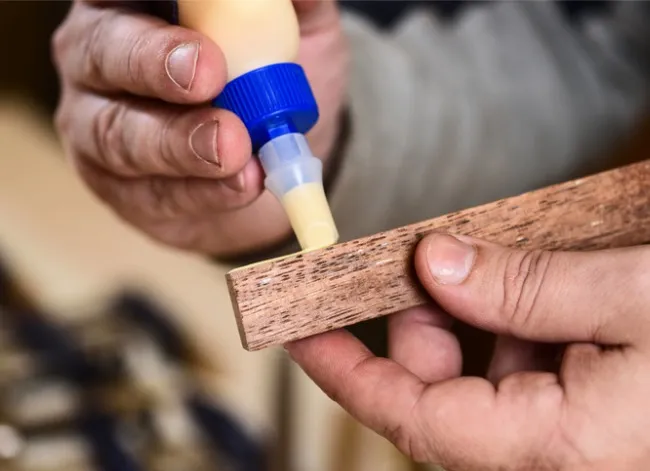
Temperature and Humidity: How Environment Affects Drying Time
Environmental conditions are another major factor that affects how long it takes for wood glue to dry. Extreme temperature or humidity levels can slow down or speed up the drying process.
- Temperature: Wood glue generally dries faster in warmer conditions. The ideal temperature range for drying is between 65–75°F (18–24°C). If the temperature is too cold, the glue will take longer to set and cure. On the other hand, if the temperature is too hot, the glue might set too quickly, resulting in a weaker bond.
- Humidity: High humidity can extend the drying time of wood glue. When the air is humid, the moisture in the glue evaporates more slowly. This results in a longer drying time. Conversely, low humidity speeds up the drying process by allowing the moisture in the glue to evaporate more quickly.
If you’re trying to figure out how long does it take for wood glue to dry, consider the weather and indoor conditions. A dry, warm room is ideal for faster drying times.
Application Thickness: How Glue Layer Affects Drying Time
The amount of glue you apply also affects how long it takes for wood glue to dry. Thicker glue layers naturally take longer to dry because the excess glue must dry from the outside in. The moisture inside the thick layer takes longer to evaporate.
To accelerate the drying time, apply a thin, even coat of glue on both surfaces being bonded. This ensures that the glue can dry faster and create a stronger bond. A thin layer also ensures that there is less excess glue to squeeze out from the joint, reducing mess and waste.
Typical Drying Times for Wood Glue
When considering how long does wood glue take to dry, it’s important to understand both the initial set time and the full cure time. These two phases are crucial to getting a strong bond.
Initial Set Time: When Can You Handle Your Project?
The initial set time is the amount of time it takes for the glue to form a bond strong enough that the pieces will not shift or come apart when handled. During this time, the glue becomes tacky and begins to harden. Typically, for most wood glues, this initial setting phase takes between 30 minutes and 1 hour.
However, while the glue may feel dry to the touch, this does not mean it is fully bonded. It’s important not to move on to the next steps in your project until this initial setting phase is complete.
Full Cure Time: Achieving Maximum Strength
Full curing is the period when the glue has dried completely and achieved maximum strength. This phase can take anywhere from 24 to 72 hours, depending on the glue type and environmental conditions. During the curing phase, the glue continues to bond and harden, ensuring a strong, durable joint that can withstand stress.
For most PVA glues, 24 hours is the standard full cure time. Epoxy and polyurethane glues, on the other hand, may require up to 48 hours or more for full curing. If you are working on a high-stress project or something that requires durability, always wait for the full cure time to pass before handling or putting weight on the joint.
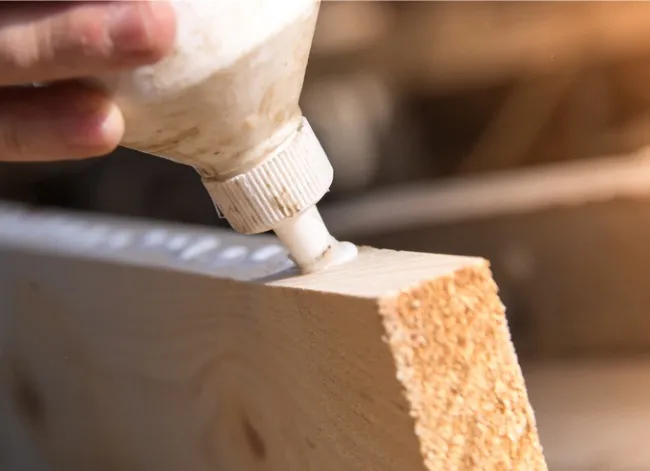
How to Speed Up Wood Glue Drying Time
Sometimes you may need to speed up the drying process without compromising the strength of the bond. Here are a few tips to help accelerate the drying time.
Optimal Temperature and Humidity Conditions: Create the Ideal Environment
One of the best ways to speed up wood glue drying is to control the environmental conditions. Make sure the room is warm and dry. Use a space heater or fan to maintain an optimal temperature of 65–75°F (18–24°C). Lower humidity also helps reduce drying time.
By controlling these factors, you can ensure that the glue will dry faster and more efficiently. It’s essential, however, to avoid extreme conditions such as high heat, which could cause the glue to set too quickly and result in a weak bond.
Thin Layers and Proper Clamping: Encourage Faster Drying
Applying a thin layer of glue and ensuring proper clamping is another effective way to reduce drying time. Thin glue layers dry much faster because the moisture has less material to evaporate from. Additionally, clamping the pieces together correctly ensures that the glue spreads evenly and doesn’t pool in areas, which could slow down the drying process.
Proper clamping also prevents the wood from shifting during the initial setting phase, ensuring a strong and even bond.
Use of Accelerators: Commercial Products or Natural Methods
If you need to speed up the drying time further, there are commercial accelerators available for most types of wood glue. These products can help activate the glue and make it set more quickly. Some natural alternatives include using a fan to circulate air or placing the glued pieces in front of a dehumidifier.
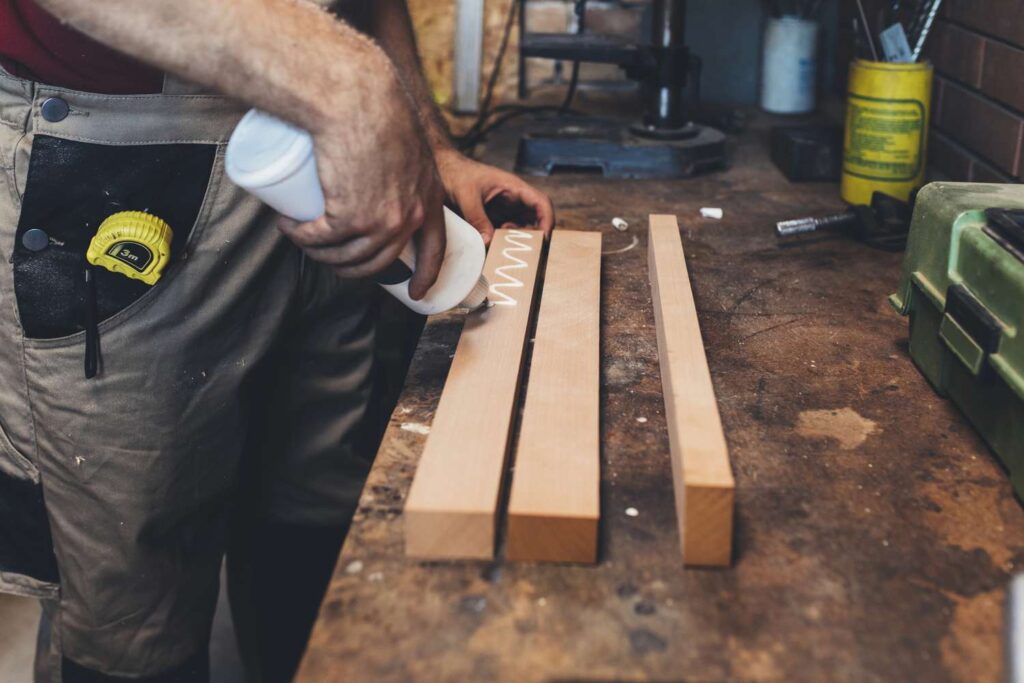
What to Do if Your Wood Glue is Taking Too Long to Dry
If you’ve noticed that your wood glue is taking longer than expected to dry, don’t panic. First, check the temperature and humidity. If the conditions aren’t ideal, consider moving the project to a warmer, drier area.
If you’ve used thick layers of glue, consider scraping off any excess and reapplying a thinner coat. Too much glue can slow down the drying process significantly.
Can You Speed Up Drying Time Without Compromising Bond Strength?
While it’s tempting to rush the drying process, it’s important to keep in mind that faster isn’t always better. Using excessive heat, pressure, or accelerators can negatively affect the bond strength of the glue.
Ensure that you follow the manufacturer’s recommendations for drying times and don’t cut corners. The bond strength and durability of your project depend on allowing the glue to dry properly. Rushing can lead to a weaker joint or even failure.
When to Avoid Rushing: The Importance of Full Cure Time
Even though the glue may seem dry, it’s critical to wait for the full curing period before using the project. This ensures that the glue has reached its maximum strength. Handling the project prematurely could result in a weak joint that might fail under stress. Always resist the temptation to use the project before the glue has fully cured.
Conclusion: Mastering Wood Glue Drying for Better Results
Now that you have a better understanding of how long does wood glue take to dry, it’s important to apply this knowledge to ensure successful, long-lasting woodworking projects. From understanding the different types of glue and the factors that influence drying time to knowing how to speed up the process without sacrificing bond strength, the more you learn about wood glue, the better your results will be.
By being patient and allowing the glue the time it needs to dry and cure fully, you’ll ensure stronger and more durable wood joints. With the right techniques, your woodworking projects will last for years to come.